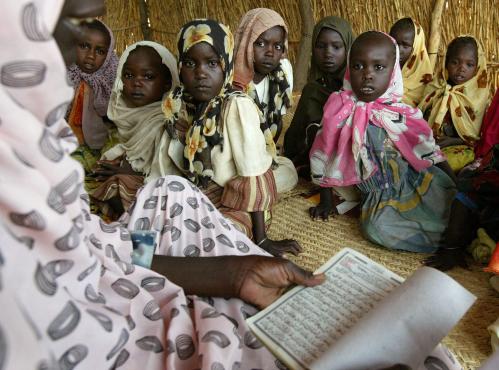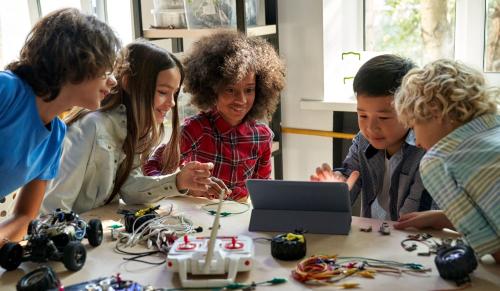This year, the Center for Universal Education (CUE) at Brookings is 20 years old. In 2002, Gene Sperling founded the center to help advance the U.N.’s Millennium Development Goals and was deeply involved with the establishment and early governance of the Education for All Fast Track Initiative, the predecessor of the Global Partnership for Education. We have traveled far over the last two decades. Much of the center’s work over the first decade was dedicated to this type of strengthening education ecosystems work at the global level. We have been proud to collaborate with many partners—often going from research to recommendations to action (e.g., the Global Business Coalition for Education, the U.N. Special Envoy’s Office for Global Education, the Learning Metrics Task Force, and the Education Commission)—to help elevate education on the global agenda.
Today, as CUE looks toward our third decade of work, we plan to build on our existing efforts to work with partners in education jurisdictions around the world to advance the U.N.’s Sustainable Development Goals (SDGs). Since 2016, we have been partnering with approximately 100 partners in 40 countries around the world from governments to civil society organizations to the private sector to work collaboratively on identifying and scaling evidence-based, contextually relevant and impactful change. Working with our partners, we have worked across an array of important topics from understanding the range of competencies young people need to thrive in a fast changing world to identifying innovations that help leapfrog education to change management processes that help sustainably embed new approaches inside education systems to processes that center women and girls’ voices to advance gender-transformative educational approaches.
Faced with the deep impacts from the COVID-19 pandemic alongside the climate crisis, the rise of authoritarianism, increasing economic inequality, and a wave of fake news the U.N. Secretary General calls an “infodemic,” it is clear that education systems must not only recover from lost instructional time but deeply pivot to live up to their potential to be a transformative social service in communities around the world.
Moving forward, we will bring all our work together under the shared goal of transformation. We will focus our efforts, working even more deeply with our partners, to help advance education system transformation that can get jurisdiction leaders and their partners closer to the vision embedded in the SDGs: equitable and relevant education that helps everyone become a lifelong learner. Faced with the deep impacts from the COVID-19 pandemic alongside the climate crisis, the rise of authoritarianism, increasing economic inequality, and a wave of fake news the U.N. Secretary General calls an “infodemic,” it is clear that education systems must not only recover from lost instructional time but deeply pivot in order to live up to their potential to be a transformative social service in communities around the world.
To kick off our new vision for advancing education system transformation over the next decade, we are sharing five publications focused on transformation. We hope these inspire conversation and debate. They are intended to explore education transformation’s urgency, the hurdles faced, and the various pathways needed for advancement. These pieces can be explored in any order, and we invite you to read them, critique them, and share your thoughts with us.
1. ‘Transforming education systems: What, why, and how’
In this piece, coauthors David Sengeh and I provide a big-picture look at what transformation is, why it is important, and some steps to engage in a transformation journey. We argue that education system transformation should entail “a fresh review of the goals of your education system—are they meeting the moment we are in, tackling inequality and building resilience for a changing world, fully context aware, and owned broadly across society—and then fundamentally positioning all components of your education system to contribute toward this shared purpose.” We go on to propose three main steps that system leaders in particular can take to advance transformation in their community or country (Figure 1): This “participatory approach” to transformation draws on evidence from multiple countries on what are major barriers to and accelerators of education system change.
Figure 1. The participatory approach to transformation

2. ‘Transforming education for holistic student development: Learning from education system (re)building around the world’
This piece was developed through close collaboration with scholars in almost 10 universities around the world. The lead authors, Amanda Datnow, Vicki Park, Donald Peurach, and James Spillane, examine the twin questions: “What would it mean—and what would it take—to build education systems that develop every child as would that child’s own parents? Is there evidence that it is possible to (re)build academically focused education systems to support holistic student development?” They argue that this shift—from academic only to holistic development—is essential if systems are to transform to help young people thrive. To answer this question, they worked with 10 scholars—Juan Bravo, Whitney Hegseth, Jeanne Ho, Devi Khanna, Dennis Kwek, Angela Lyle, Amelia Peterson, Thomas K. Walsh, Jose Weinstein, and Hwei Ming Wong—to examine reform journeys across seven jurisdictions. With a focus on high and middle-income countries, they examined the barriers and strategies seven systems used to expand toward holistic learning, including in districts, states, or national ministries in Chile, Canada, India, Ireland, Singapore, the United States, and in the cross-national International Baccalaureate system.
Ultimately, they identified 10 major lessons coming out of the transformation journeys across the seven systems: 1) Engage diverse stakeholders, 2) Construct coherence, 3) Manage the equity and rigor tension, 4) Build social infrastructure, 5) Develop instructional designs, 6) Design educational infrastructure, 7) Balance common conventions with local discretion, 8) Distribute leadership, 9) Support infrastructure use, and 10) Monitor practice and performance.
3. ‘Systems thinking to transform schools: Identifying levers that lift educational quality’
This piece, coauthored by Bruce Fuller and Hoyun Kim, provides a deep dive into the historical roots of systems thinking and how it has informed approaches to education reform. It primarily draws upon the intellectual traditions and literature in high-income countries but also illustrates how these ideas have traveled to middle- and low-income countries. After reviewing the organizational levers inside education systems that touch classrooms, it outlines the diverse approaches to education reform informed by systems thinking. The authors argue that there are at least four distinct education change approaches inspired by systems thinking: 1) standards-based accountability, 2) instructional sub-system, 3) teaching guild, and 4) ecological approach.
Each pathway reflects a distinct analysis of the core problems holding back system improvement and where the power lies to address the problems. Ultimately, the authors argue that although it is not “either, or” in terms of selecting one pathway over another, there is a need in many parts of the world to thaw out “highly institutionalized habits and routines” in favor of harnessing the capacity to innovate and be responsive to particular community needs by local schools and education ecosystems. They conclude with a set of key questions leaders should ask themselves when reflecting on how to harness systems thinking for improving education.
4. ‘Shared priorities to transform education systems: Mapping recovery and transformation agendas’
In this piece, I argue that the United Nation’s Transforming Education Summit (TES) is a unique opportunity for education to be at the top of the global agenda, and to make the most of this moment, actors in the global education ecosystem will need to coalesce around a shared narrative, finding ways to work synergistically—not competitively—in education jurisdictions around the world. I start by reviewing the past success of the global education community in coming together behind the shared “access plus learning” narrative in the lead-up to the development of the SDGs. I then map the range of agendas generating attention and debate in the TES process, especially at the presummit meeting in Paris this past June. I argue that there is a broad distinction between those actors focusing on pandemic recovery versus those focused on longer-term transformation. But while both approaches are needed—and indeed complementary—there is a need to forge closer linkages across agendas.
The piece highlights six of the main agendas prominently discussed in the TES process to date and analyzes them in relation to the level of support they receive by global actors versus actors representing “voices inside the system”—namely students, parents, teachers, local civil society, and governments. While this analysis only highlights some of the agendas and debates underway, it offers three recommendations in order to catalyze dialogue around where there are clear areas of synergy and where deeper discussion is needed: 1) Work collaboratively on addressing equity and inclusion, which is a broadly shared priority, 2) find ways of working more closely together across complementary agendas focused on building young people’s competence and capability—namely foundational learning, student well-being, and 21st century skills for work and citizenship, and 3) engage in deep discussions on who has the power—global versus voices inside the system actors—to define the purpose of education and guide transformation efforts.
5. Big Education Conversation
Together with a coalition of partners, including Big Change in the United Kingdom alongside multiple government and civil society actors, CUE is launching at TES the global Big Education Conversation. This initiative draws on CUE’s research on mapping the purpose of education across family members, teachers, students, and school leaders as an approach to kickstart conversations about education transformation in communities. One year ago, CUE launched “Collaborating to transform and improve systems: A playbook for family-school engagement” and has since been piloting the playbook’s Conversation Starter Tools (surveys and conversation guidance) in over 10 countries across the Americas, Africa, and Asia.
Last year Big Change adapted CUE’s survey questions as part of a national Big Education Conversation in the U.K. about the purpose of education. As described above in the first “P” (Purpose) of the participatory approach to education, there is strong evidence to suggest that developing a shared understanding across society of the goals of the education system can accelerate transformation and failing to do so can block it. Hence, the Big Education Conversation initiative is a scalable tool to catalyzing discussions around the purpose of education and can be used by decisionmakers to advance participatory policymaking and by youth, parent, teacher, or community networks to catalyze demand for opening dialogue around the purpose of education. CUE team members Akilah Allen, Emily Morris, Laura Nora, Sophie Partington, Claire Sukumar, and I are leading this work and invite anyone to take up and use the Big Education Conversation approach in their communities and countries.







Commentary
The next decade of education transformation: 5 reports to spur debate and discussion
September 15, 2022